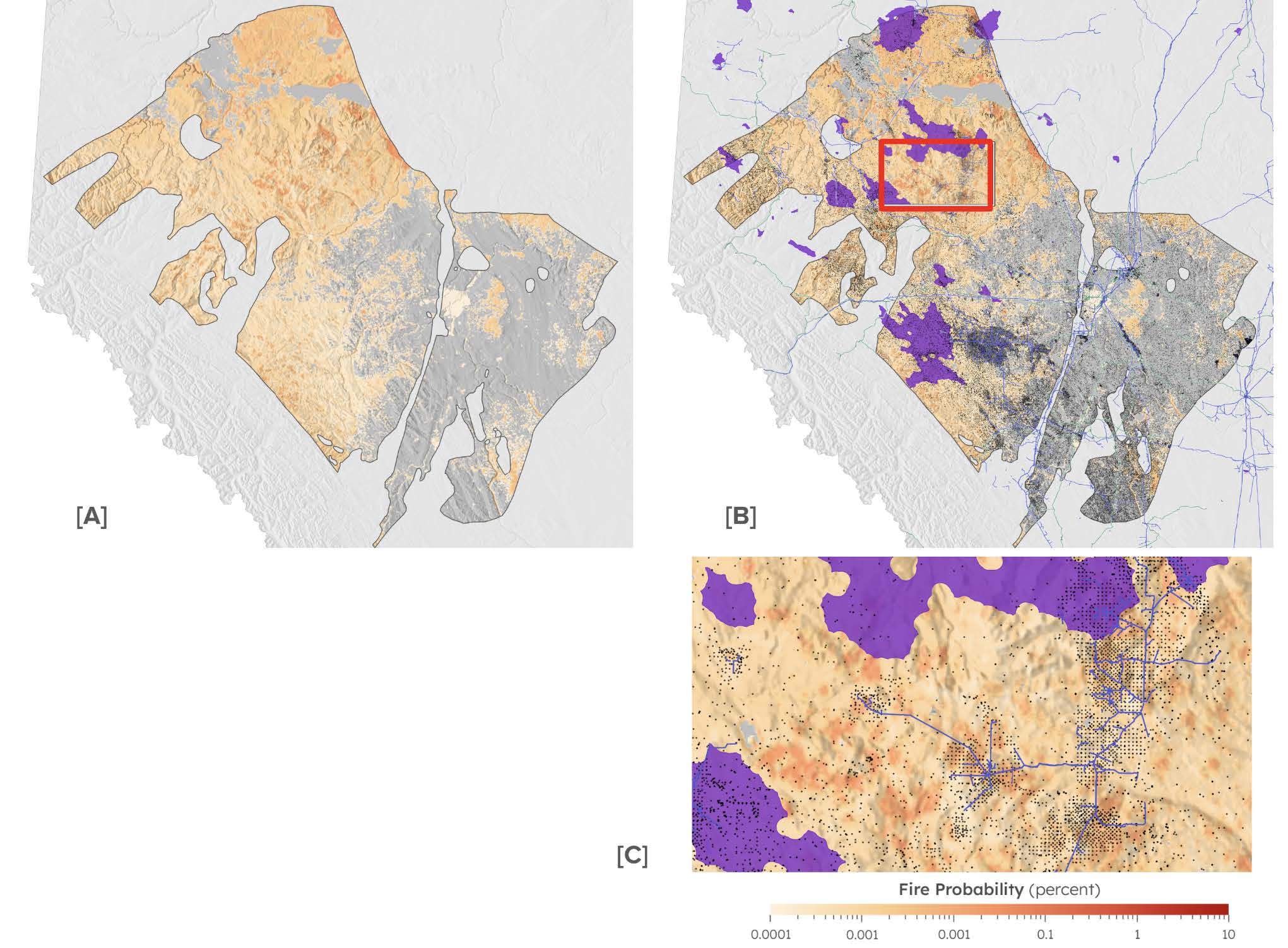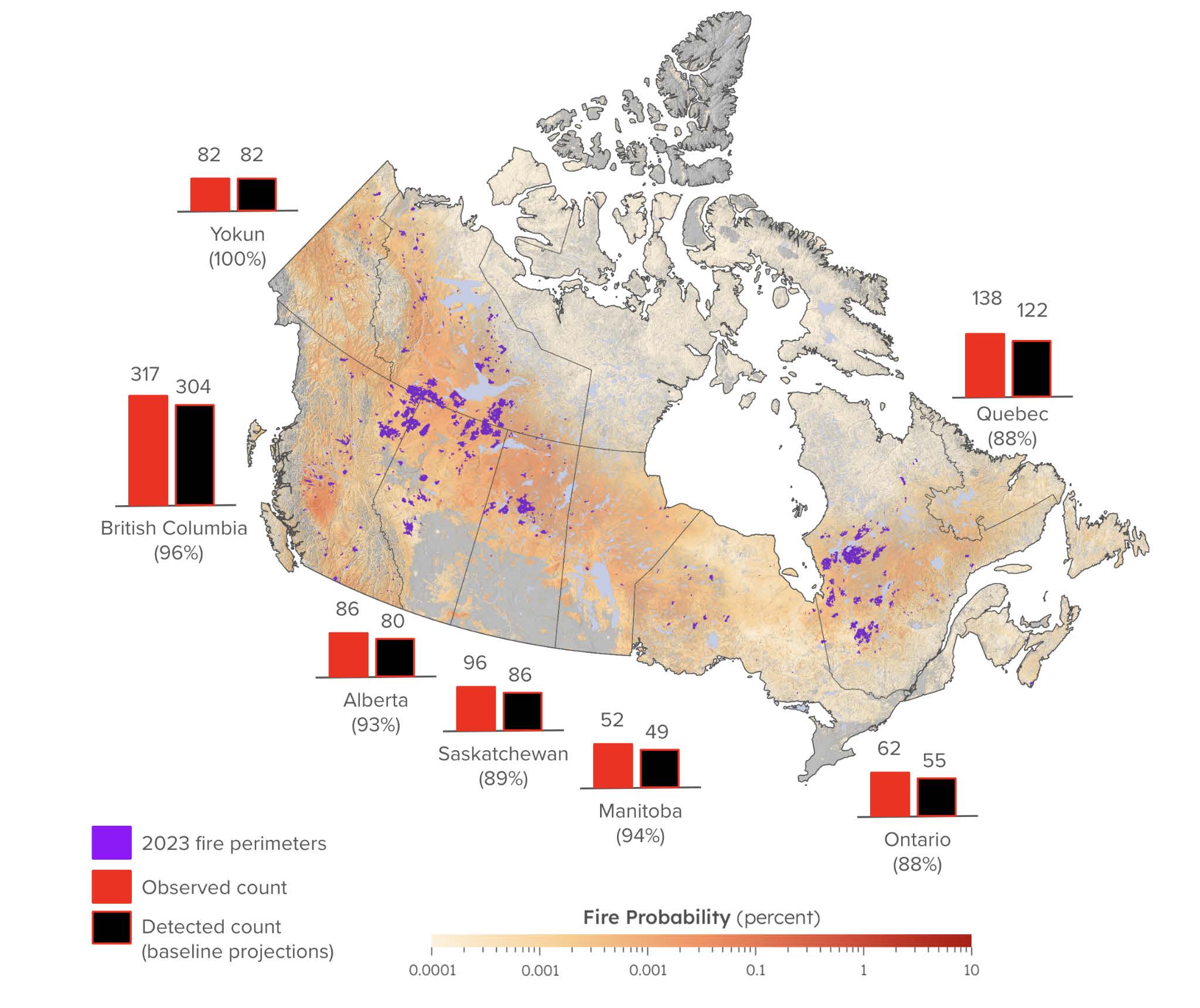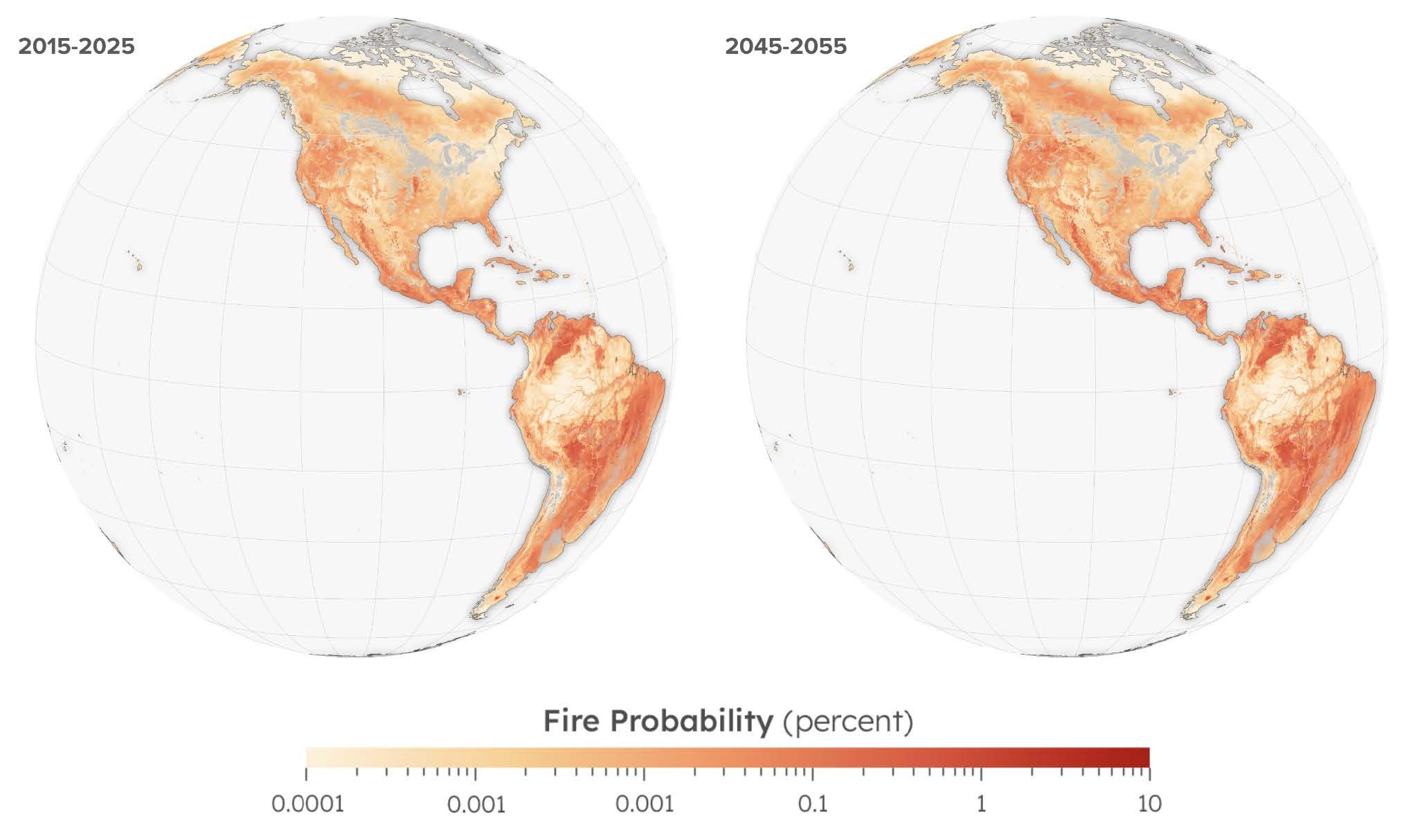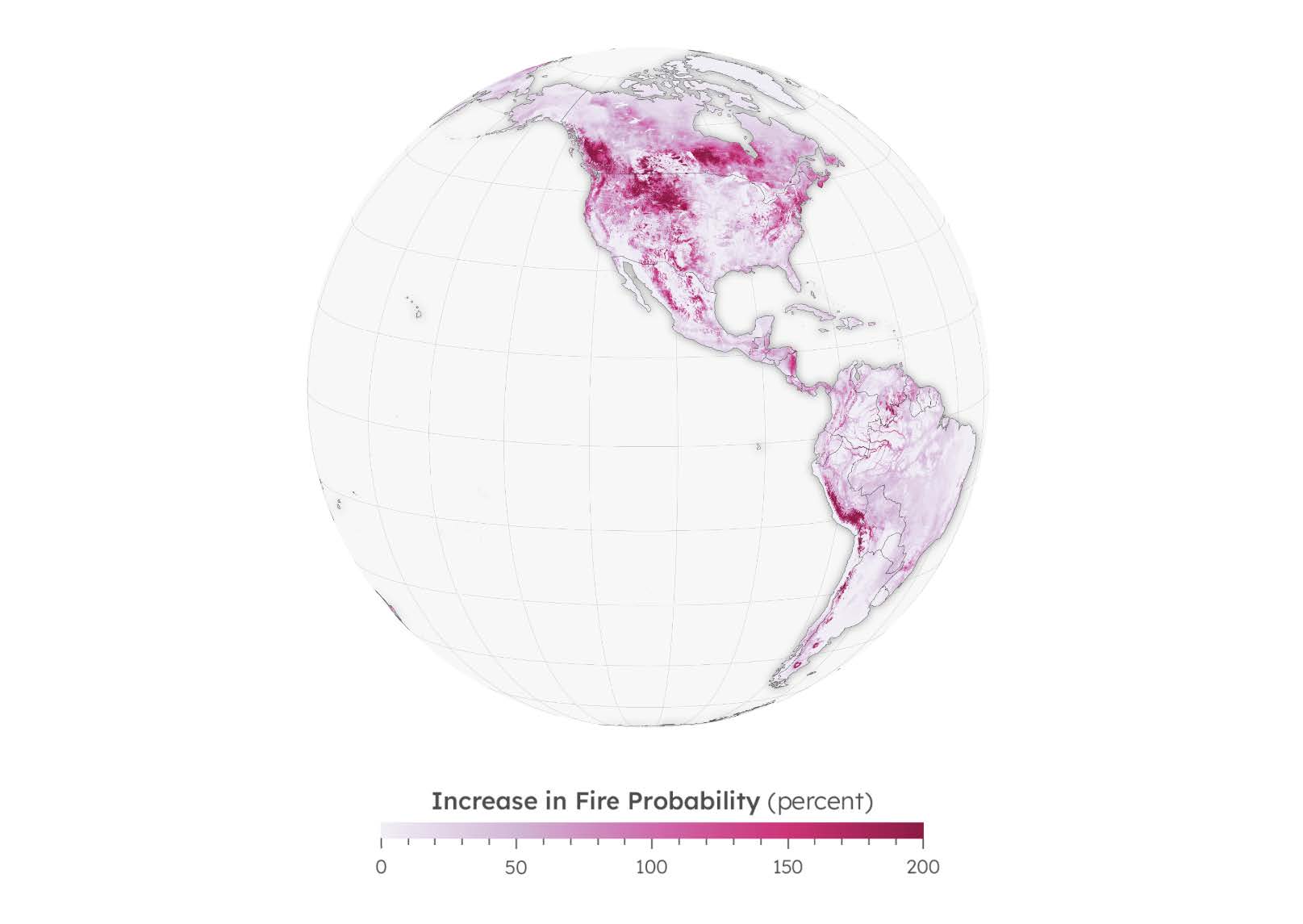Our partnership with Yield Book: Towards climate-informed metrics in sustainable finance


The 2023 Canadian wildfire season inflicted considerable damage and interruption to the nation's oil and gas production sectors (link). Throughout the summer season, Alberta's critical shale gas regions faced persistent extreme wildfire warnings, jeopardizing the safety of 2.7 million barrels of oil produced each day. Due to the fires, Chevron announced a complete halt of operations in Kaybob Duvernay fields in central Alberta, and Paramount ceased operations at a natural gas processing facility and suspended production across various fields, according to the New York Times (link). The resulting interruptions from these wildfires, in a high production region like Canada, contributed to an uptick in global oil prices.
Figure 1 Wildfire impacts to Duvernay shale formation in Alberta, CA in 2023. [A] Baseline wildfire risk exposure map over Duvernay shale formation [B] Overlay of oil and gas pipelines (blue), oil drilling sites (black) and 2023 fire perimeters (purple) causing suspended operations. [C] Zoom in on north western formation highlighting impacts to oil fields and pipeline infrastructure. Wildfire data provided by Sust Global. Shale formation outline courtesy Alberta Geological Survey.

The 2023 Canadian wildfires are the most recent example of catastrophic events driven by extreme fire weather (link). Around 4% of Canada’s total forest area burned in 2023, an area approximately twice the size of Portugal. The wildfires more than doubled the previous records for burned areas and carbon emissions (link). Such events are likely the cause of business interruption and structural damage leading to financial loss.
Despite the unprecedented nature of the wildfires, Sust Global’s wildfire model captures over 93% of the observed 2023 Canadian wildfires (Fig 2). By province, this skill ranges from over 88% (Ontario and Quebec) to 100% (Yukon) (Fig 2). This strong model performance on extreme events strengthens its credibility in making wildfire forecasts under novel climate conditions.
Figure 2 Despite the unprecedented nature of the wildfires, Sust Global’s wildfire model captures over 93% of the observed 2023 Canadian wildfires. By province, this skill ranges from over 88% (Ontario and Quebec) to 100% (Yukon). 2023 fire perimeters (purple), Observed count (red) and modeled projections counts (black) shown for each province. Perimeter dataset courtesy the Canadian wildland fire information service (link).

Projections from Sust Global’s wildfire model indicate that as the climate warms, the likelihood of such wildfire events across Canada will increase due to climate change. Increasing wildfire risk in the coming decades is driven by rising fire-prone weather, such as increasing temperatures and decreasing precipitation. Such conditions contribute to higher wildfire risk by creating drier conditions that reduce fuel moisture content, making vegetation more susceptible to ignition, and facilitating the rapid spread and intensification of wildfires due to heightened flammability and extended fire seasons.
Quantifying extreme fire weather driven wildfire probabilities and their business impacts is highly important but very complex. Many parts of the world are already experiencing weather patterns that have never been seen before, and this trend is expected to continue. As a result, the tools and models that have been used to predict wildfire risk in the past may not be sufficient in the future. Purely empirical approaches based on historical data will fail to predict fire risk under future weather conditions. This is why Sust Global has created a novel modeling approach that combines past empirical data with modern physical wildfire trends using state-of-the-art AI modeling. This hybrid approach makes reasonable predictions outside the range of training data provided by the historical record, thereby giving their model capabilities that most AI models lack. For example, Sust Global’s wildfire model can extrapolate readily interpretable insights.
Wildfires have become a common occurrence in many parts of the world, and their frequency and intensity has been on the rise in recent years. This increase in wildfire risk can be attributed to a variety of factors, but climate change is undoubtedly one of the most significant.
The challenge of forecasting wildfire risk will become even more difficult as temperatures continue to rise, droughts become more severe, and extreme weather events become ubiquitous. For example, in many US States, future fire weather indices are forecasted to be higher than anything observed in the past.
Figure 3 Global wildfire risk projections for baseline and future wildfire projections under the Business as Usual (BAU) / High Emissions climate scenario (SSP5-RCP8.5). Mapping on probabilities in log scale from 0.0001 to 10%.

Sust Global’s multi-scenario wildfire projection model utilizes millions of satellite observations of historic fires with high-resolution data on dozens of variables that contribute to fire risk – including daily precipitation and temperature, local topography and land cover, as well as fire suppressibility and ignition sources. This is the typical AI approach – utilizing large quantities of big data, heavily leveraging GPU driven compute, and enabling the model to learn complex relationships that would be hard for a human to decipher. However, the key innovation is that Sust Global has built a modeling paradigm around two simple interpretable layers that disaggregate overall fire risk at a location into baseline fire risk and weather-dependent fire risk. This allows for interpretation of these layers, and lets their model make reasonable, scientifically-informed predictions in unseen contexts outside of the range of data it has been trained on.
The result is a highly performant model that provides multi-scenario wildfire projections at global scale. The “peak fire weather” seen in eastern Canada over May-August 2023 was at least two times more likely and 20% more intense due to human-induced climate change, according to a recent study (link).
S&P Global Sustainable1 presents Physical Risk Exposure Scores and Financial Impact scores to support companies, investors, governments and other stakeholders seeking to understand and manage the physical and financial exposure of corporations and portfolios to climate change.
Applying physical risk datasets to the S&P Global 1200, has shown (link) that 92% of the world's largest companies have at least one asset at high exposure (score >75 out of 100) to a climate change physical hazard by the 2050s, rising to 98% by the 2090s under the business as usual (SSP5-RCP8.5) climate scenario. It has also been reported that more than 70% of S&P Global 1200 companies in the Utilities, Energy and Materials sectors have at least one asset where the physical risks of climate change are equivalent to 20% or more of that asset's value under the BAU scenario.
Figure 4 Projected increase to global wildfire risk from baseline (2010-2020) and future (2045-2055) under the Business as Usual (BAU) / High Emissions climate scenario (SSP5-RCP8.5), expressed as percentage of baseline risk. Mapping on percentages in linear scale from 0.0 to 200% (representing a 3-fold increase).

Sustainable1 will leverage the performance and high resolution of the Sust Global wildfire projections to quantify and estimate the operational and financial impacts to global businesses from future wildfires. This will enable companies, investors and other stakeholders to better understand potential risks from wildfire to critical infrastructure and better prepare, manage and potentially mitigate business impacts from future extreme catastrophic wildfire events like the 2023 Canadian wildfires.
About S&P Global Sustainable1
S&P Global Sustainable1 is the central source for sustainability intelligence from S&P Global Sustainable1 matches customers with the ESG products, insights and solutions from across S&P Global's divisions to help meet their unique needs. Our comprehensive coverage across global markets combined with in-depth ESG intelligence provides financial institutions, corporations and governments an unmatched level of clarity and confidence to successfully navigate the transition to a sustainable future. Our data and well-informed point of view on critical topics like energy transition, climate resilience, positive impact and sustainable finance allow us to go deep on the details that define the big picture so customers can make decisions with conviction. To learn more, please visit: www.spglobal.com/esg
About Sust Global
Sust Global is the Category Leader in climate risk analytics, serving intelligent climate data solutions to institutional investors. Our suite of cutting edge analytical products enable customers to decode and quantify the financial impact of extreme climate events and integrate these insights directly into existing investor workflows. Sust Global’s platform fuses cutting edge climate models, satellite-derived observational data and geospatial datasets with proprietary AI techniques to provide globally accurate insights on extreme climate events. Use cases for Sust Global’s data analytics and APIs include comprehensive investor due diligence, risk management and climate-informed portfolio strategy.



We use cookies to give you the best online experience. Please let us know if you agree to all of these cookies.